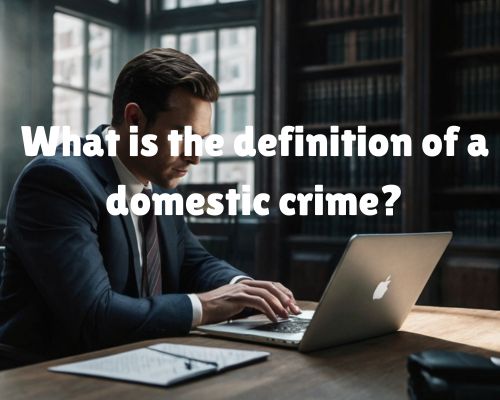
What is the Definition of a Domestic Crime?
Understanding Legal Perspectives
Charles Jimerson of Private Investigator West Palm highlights that “Domestic crimes encompass a range of abusive behaviors within intimate or family relationships. This includes physical, sexual, psychological, and emotional abuse, as well as threats and economic control used to intimidate or manipulate victims.”

These patterns of behavior can be committed by current or former spouses, dating partners, family members, or cohabitants.
Law enforcement agencies recognize domestic violence as a serious crime that necessitates intervention and legal action.
Courts may issue protective orders and impose penalties on offenders to prevent further harm.
Situations involving domestic crime are complex and multifaceted. They often need coordinated efforts between legal, social, and healthcare services to support victims effectively.
Understanding the dynamics of domestic abuse is crucial for identifying and addressing such crimes.
By recognizing signs of domestic violence and knowing how to respond, you contribute to creating a safer environment for victims and holding perpetrators accountable.
Understanding Domestic Crime
Domestic crime encompasses various abusive behaviors used by individuals within intimate or familial relationships to exert control and power.
It is crucial to recognize the types, the individuals involved, and the legal protections available. Let us know and understand these with Charles Jimerson of Private Investigator West Palm.
Types of Domestic Crime
Physical Violence: This includes assault, battery, and in severe cases, murder.
Physical violence can also extend to child abuse and marital rape.
Emotional and Psychological Abuse: Forms of emotional and psychological abuse include verbal threats, intimidation, and manipulative tactics used to undermine the victim’s mental well-being.
Sexual Abuse: Non-consensual sexual acts, including rape and marital rape, are categorized as sexual abuse.
Economic Abuse: This involves controlling or restricting a partner’s financial resources to create dependency and control.
Stalking and Harassment: Persistent following, monitoring, or threatening behavior, either physically or digitally, constitutes stalking.
Victims and Perpetrators
Victims can be women, men, children, or any intimate partner, including former spouses.
Pregnant women are often at heightened risk.
Perpetrators are typically current or former spouses, partners, or family members like parents or siblings.
The abusive behavior aims to maintain power and control over the victim.
Understanding the dynamics of child abuse is essential, as children are often indirect victims, affected by witnessing abuse.
Legal and Protective Framework
Violence Against Women Act: This federal act provides funding for victim services and strengthens legal actions against perpetrators.
Restraining and Protective Orders: Victims can seek these through the courts to keep abusers at a distance, helping to prevent further abuse.
Law Enforcement: Officers play a crucial role in responding to domestic violence reports, enforcing protective orders, and ensuring victims’ safety.
National Domestic Violence Hotline: This resource offers 24/7 support for victims seeking help and guidance.
The legal system including courts, imposes criminal penalties on perpetrators and provides civil remedies like custody arrangements to protect victims.
Social Context and Support Systems
The social context of domestic crime and the available support systems play a crucial role in either exacerbating or alleviating the impacts of abuse on victims. Understanding the dynamics of these factors is essential for effective intervention and support.
Influencing Factors
Socioeconomic conditions often set the stage for domestic crime.
Poverty, lack of education, and limited access to financial resources can make it difficult for victims to leave abusive relationships.
Cultural norms and societal expectations can also perpetuate abuse.
In some cultures, traditional views on gender roles can lead to power imbalances and control issues within relationships.
The rise of technology has introduced new ways for abusers to intimidate and control victims, making emotional and psychological abuse harder to escape.
Substance abuse, particularly involving alcohol, can increase the risk of domestic crime.
Abusers often use substances as an excuse for their behavior, and victims may also turn to substances as a coping mechanism.
Assistance and Rehabilitation
Numerous victim support services aim to aid those affected by domestic crimes.
Organizations such as the National Domestic Violence Hotline provide immediate help and resources for victims.
Shelters offer a safe haven for those fleeing abusive situations. They give them time to rebuild their self-esteem and plan their next steps.
Counseling services are vital for helping victims process their experiences and regain emotional stability.
Educational programs can empower victims by providing knowledge on self-defense and legal rights.
Access to financial resources can make a critical difference. It enables victims to escape economic abuse and achieve independence.
Victim services often extend to self-defense workshops, counseling, and financial aid to support long-term recovery and autonomy.
The Centers for Disease Control and Prevention emphasize the importance of comprehensive support to minimize the societal impact of domestic crimes.